Uterine Rupture Lawsuit: Did Your Baby Suffer Birth Injury or Complications From A Uterine Rupture?
Uterine rupture, while rare, represents a critical juncture where the realms of obstetric care and legal advocacy intersect, particularly when it results in birth injuries or complications. This medical emergency not only necessitates swift and precise intervention but also raises questions about the standard of care provided during labor and delivery. If your baby suffered from complications stemming from a uterine rupture, understanding the nuances of medical negligence and the potential for legal recourse is paramount. The journey towards seeking justice and compensation for such a traumatic event is fraught with complexities, inviting those affected to explore the legal pathways that may lie ahead.

Understanding Uterine Rupture
Uterine rupture, a rare but serious complication during pregnancy, involves the tearing of the uterine wall. This condition primarily occurs in women who have previously undergone a cesarean section but can also affect those with uterine scars from other surgeries or invasive procedures. The integrity of the uterine wall can be compromised, making it susceptible to rupture under the stress of labor. Although less common, uterine rupture can also spontaneously occur in women without prior uterine surgery, often with little warning. The diagnosis is typically made based on clinical symptoms and, in some cases, imaging studies. Immediate medical attention is crucial to manage this emergency situation effectively. Understanding the risk factors and early signs of uterine rupture is essential for pregnant women and healthcare providers to mitigate this life-threatening condition.
Complications From Uterine Rupture
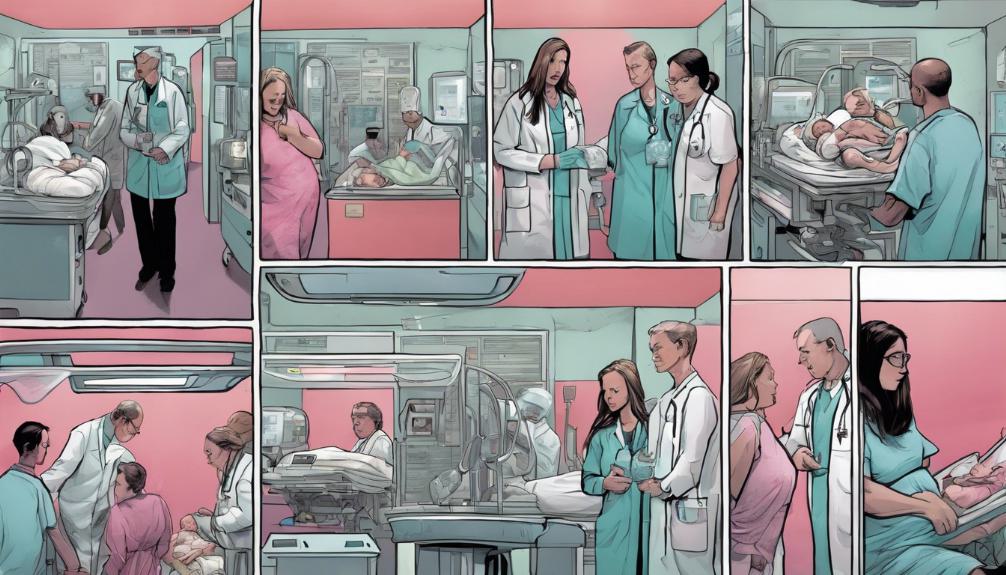
Complications arising from a uterine rupture can have severe and life-altering consequences for both the mother and baby, including the risk of hypoxic-ischemic injuries and significant blood loss. This traumatic event may lead to shock due to hemorrhage and necessitates immediate medical intervention to prevent further life-threatening issues. For the mother, complications can extend to the requirement of a hysterectomy, which has profound implications for future fertility and psychological well-being. Furthermore, the risk of infection and potential for subsequent surgeries to repair the uterus or manage complications adds to the gravity of the situation. These complications underscore the critical need for prompt diagnosis and treatment to mitigate the risks associated with this rare but serious obstetric emergency.
Birth Injuries Explained

Birth injuries, encompassing a range of physical and cognitive impairments that may occur during labor and delivery, significantly impact the health and development of a newborn. These injuries can arise from complications such as uterine rupture, where the integrity of the uterine wall is compromised. Consequences include lack of oxygen leading to birth asphyxia, brain damage, cerebral palsy, and hypoxic-ischemic encephalopathy, among others. Such conditions not only affect the immediate health of the baby but can also lead to long-term developmental challenges. Additionally, uterine rupture can cause severe hemorrhaging, posing significant risk to both the mother and child, and in the most severe cases, may result in death. Understanding these risks underscores the importance of careful monitoring and timely intervention during childbirth.
Treatment Options Available
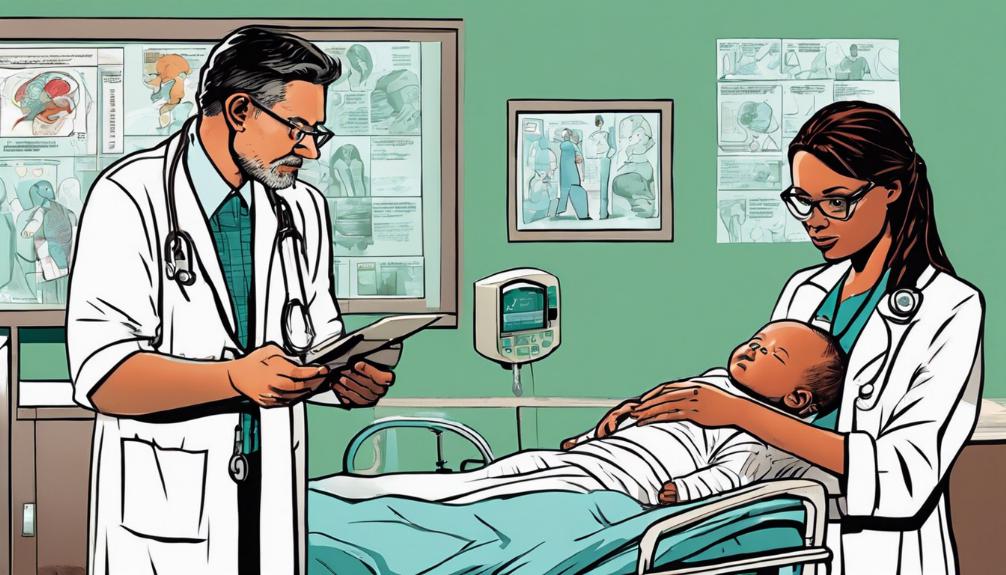
Recognizing the serious implications of uterine rupture, it is essential to explore the array of treatment options available to manage this obstetric emergency effectively. Immediate medical intervention is crucial for the wellbeing of both the mother and the baby. The primary treatment for a uterine rupture includes an emergency cesarean section to safely deliver the baby and prevent further complications. Following delivery, surgical repair of the uterus is often necessary to control bleeding and restore uterine integrity. In severe cases where the damage to the uterus is extensive, a hysterectomy may be required to save the mother's life. Additionally, blood transfusions are frequently administered to counteract significant blood loss. These measures are critical to stabilize the patient's condition and mitigate the risks associated with this life-threatening event.
Recovery After Uterine Rupture

Recovery after uterine rupture varies significantly depending on the severity of the injury and the effectiveness of the immediate medical intervention received. The patient's path to recovery may involve surgical repair of the uterus or, in severe cases, a hysterectomy. Following surgery, a period of hospitalization allows for close monitoring of the mother's physical recovery and the management of any potential complications, such as infection or hemorrhage. Blood transfusions may be necessary if significant blood loss occurred. The emotional and psychological impact on the mother and family should also be addressed, with support and counseling offered as needed. Recovery timelines can vary, and some women may face challenges related to future fertility or the decision to pursue additional pregnancies.
Uterine Rupture: The Statistics
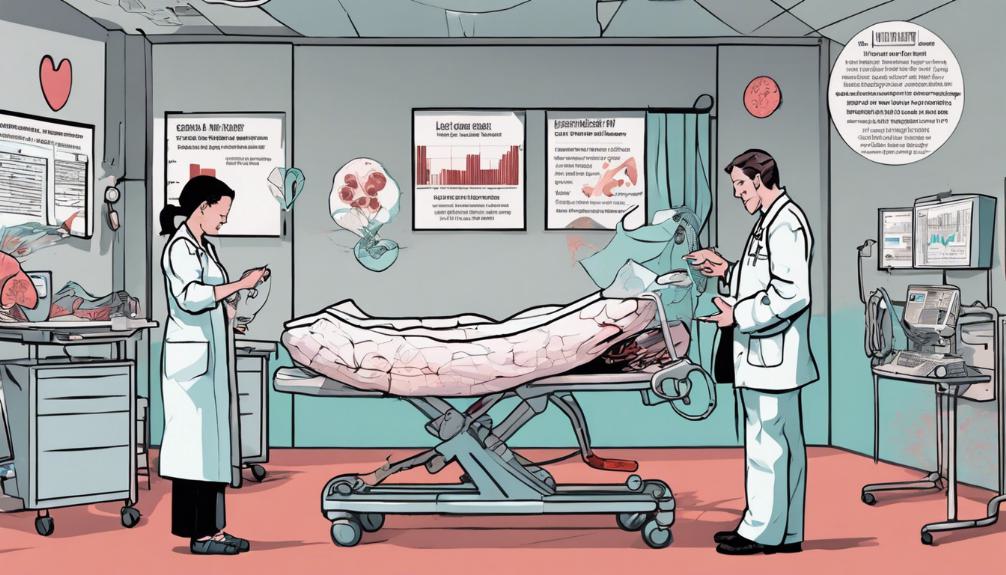
While considering the path to recovery after a uterine rupture, it's crucial to understand the associated statistics and risks that underscore the severity of this condition. Uterine rupture, a dire emergency during pregnancy or labor, occurs in less than 1% of all pregnancies. However, this rate escalates to 3.9% in cases involving women who have had two or more prior cesarean sections. The rarity of this condition does not diminish its seriousness; the consequences for both mother and baby can be life-threatening. These statistics not only highlight the critical nature of prompt medical intervention but also the importance of understanding the potential for severe outcomes. Knowledge of these figures is essential for grasping the gravity of uterine ruptures and the necessity for immediate and effective medical response.
Risk Factors Identified
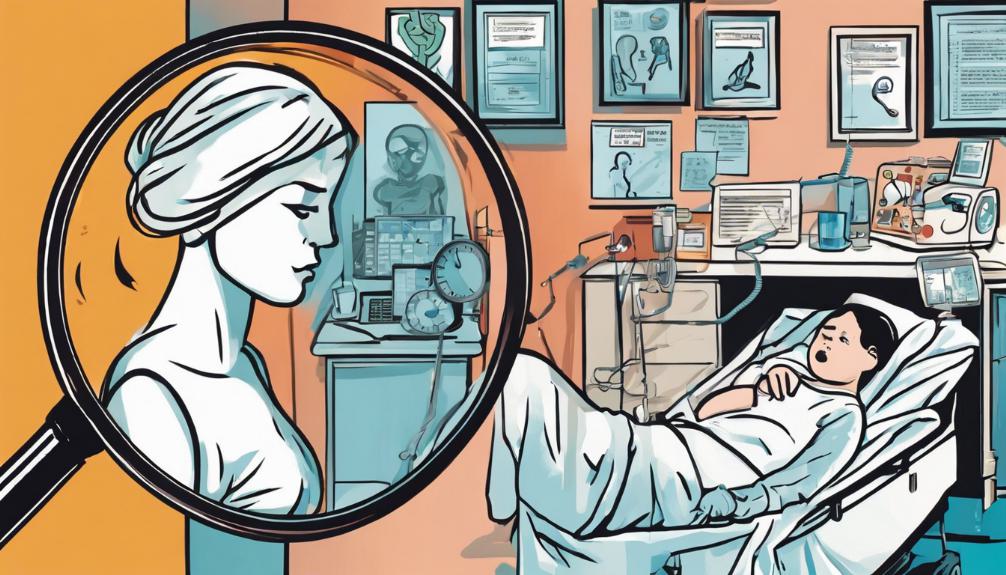
Several factors significantly increase the risk of uterine rupture, including prior cesarean sections and specific conditions of the uterus. A history of cesarean delivery is a prominent risk factor due to the scar tissue that can weaken the uterine wall. The more cesarean sections a woman has undergone, the higher her risk of experiencing a uterine rupture in subsequent pregnancies. Other conditions contributing to the risk include uterine anomalies, fibroids, or surgeries that may have compromised the structural integrity of the uterus. Additionally, labor-inducing drugs, such as oxytocin, heighten the risk by increasing uterine contractions, which can stress an already vulnerable uterus. Understanding these risk factors is crucial for expecting mothers and medical professionals to mitigate the chances of this life-threatening complication.
Legal Support Overview

Understanding the risk factors of uterine rupture highlights the critical importance of seeking specialized legal support for those affected by this traumatic event. Given the severe and potentially life-altering complications that can arise, families find themselves navigating not just medical challenges but also the complexities of the legal landscape. Engaging with experienced legal professionals who are well-versed in birth injury cases becomes paramount. These experts offer guidance through the intricate process of establishing fault, understanding medical malpractice, and ensuring that the legal rights of both mother and child are rigorously defended. Specialized legal support provides a foundational pillar for affected families, enabling them to seek justice and accountability through informed legal strategies tailored to the specific nuances of uterine rupture cases.
Compensation for Injuries

Victims of uterine rupture may be entitled to financial compensation for their injuries and the subsequent hardships they endure. Compensation aims to cover medical expenses, including emergency procedures, surgeries, and long-term rehabilitation costs. It also seeks to address non-economic damages such as pain and suffering, emotional distress, and, in tragic cases, wrongful death. The extent of injuries can range from hypoxic-ischemic encephalopathy, which can lead to conditions like cerebral palsy, to severe hemorrhaging requiring blood transfusions. The financial burden for families can be overwhelming, considering the immediate and ongoing care needs, making compensation critical for alleviating some of the financial strains. Understanding the full scope of damages incurred is essential for accurately calculating the compensation deserved.
Pursuing a Lawsuit
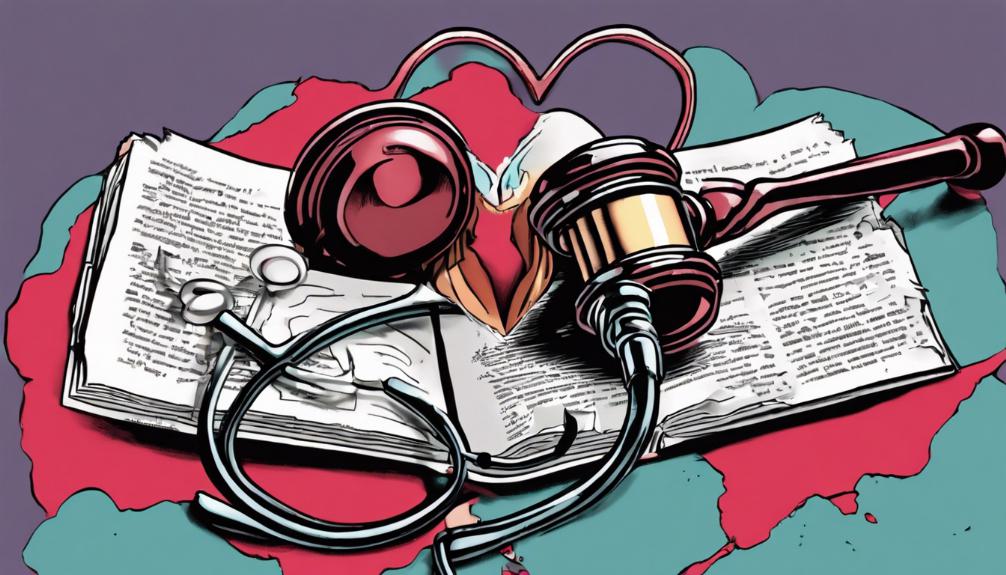
Initiating a lawsuit for uterine rupture involves navigating the complexities of medical malpractice law to seek justice and compensation for the injuries sustained. This legal action is not merely about financial restitution; it's a pursuit of accountability for the medical care that fell short of the expected standards, leading to severe, sometimes life-threatening complications for both mother and child. Parents and guardians opting to litigate are driven by the need to address the preventable harm caused by such medical oversights. Engaging in this process requires a thorough understanding of the legal rights affected by the incident and the potential impact on future health and well-being. Pursuing a lawsuit symbolizes a fight for rectification and ensures that similar errors are spotlighted for systemic improvement in maternal healthcare practices.
Steps in Legal Action
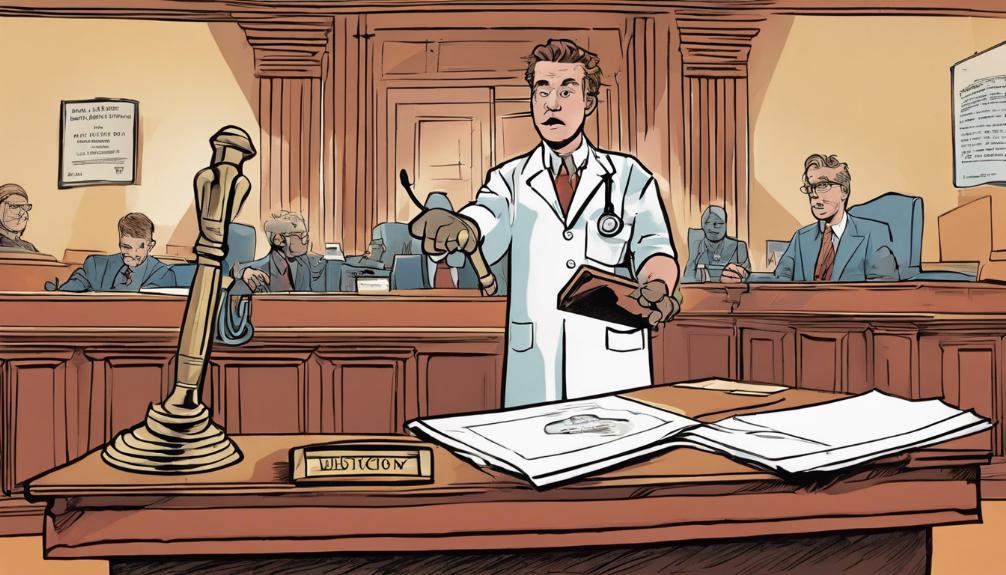
After considering the necessity of pursuing a lawsuit for uterine rupture, it is crucial to outline the procedural steps involved in taking legal action. Initially, gathering all medical records and evidence related to the birth and complications is essential. Following this, consulting with a specialized attorney who understands the intricacies of birth injury law is a vital step. The attorney will evaluate the case to determine if medical malpractice occurred and if the claim is valid. Next, filing a lawsuit involves preparing legal documents that detail the allegations against the healthcare providers. The discovery phase then allows both parties to exchange information and evidence. Finally, the case may proceed to trial or settle outside of court, depending on the circumstances.
Why Legal Advice Matters
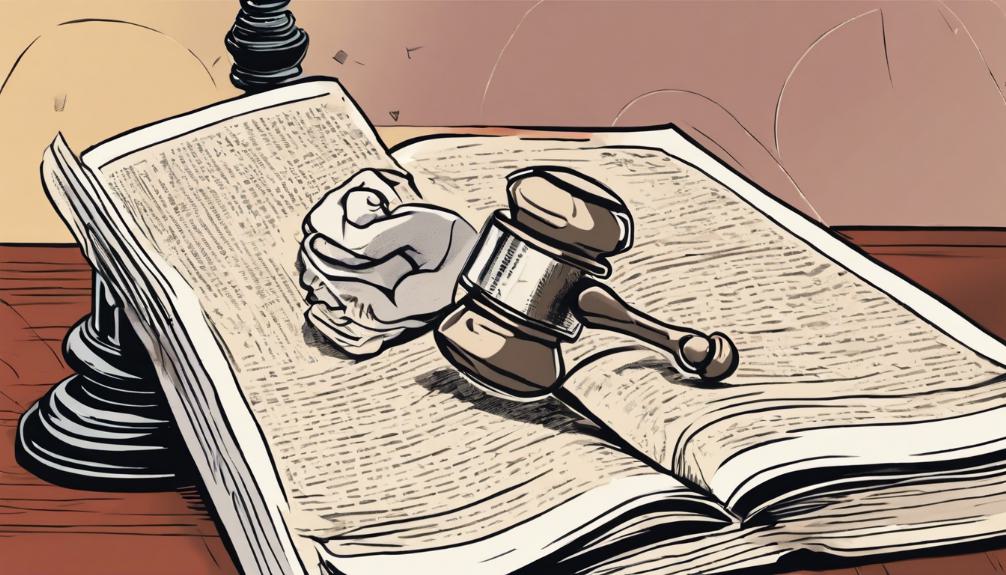
Seeking professional legal advice is crucial for navigating the complexities of a uterine rupture lawsuit effectively. Uterine rupture cases involve intricate medical details and legal nuances that require specialized knowledge to understand fully. A seasoned attorney can offer invaluable insights into the potential causes and consequences of uterine ruptures, guiding clients through the maze of medical terminology and legal procedures. Furthermore, legal experts can assess the validity and strength of a case, helping to establish negligence and liability. They also play a pivotal role in calculating appropriate compensation for the physical, emotional, and financial damages suffered. By leveraging their expertise, families can ensure their rights are protected and pursue justice for the harm endured, making legal advice an indispensable part of the process.
Contacting a Birth Injury Lawyer

Understanding the crucial role of legal advice in uterine rupture cases naturally leads to the importance of contacting a birth injury lawyer. Given the complex nature of these cases, which often involve intricate medical details and legal principles, securing a lawyer with specialized experience is vital. A skilled attorney can navigate the legal system, ensuring that the affected families receive the compensation they rightfully deserve for medical expenses, ongoing care, and emotional distress. They will meticulously investigate the circumstances surrounding the uterine rupture, identify liable parties, and argue the case with compelling evidence. Moreover, timely consultation with a birth injury lawyer can be critical, as there are legal deadlines for filing a lawsuit. Seeking professional legal assistance is a crucial step in advocating for the rights and well-being of both the mother and child.
Frequently Asked Questions
How Can I Differentiate Between Normal Post-Delivery Symptoms and Signs of a Uterine Rupture?
Differentiating between normal post-delivery symptoms and signs of a uterine rupture involves recognizing specific symptoms that are unusual or severe. Normal postpartum symptoms may include mild abdominal discomfort and vaginal bleeding. However, signs of a uterine rupture can include severe abdominal pain, abnormal vaginal bleeding, a rapid heart rate, low blood pressure, and signs of fetal distress. It is crucial to seek immediate medical attention if these severe symptoms are present.
Are There Any Long-Term Psychological Impacts on Parents After Experiencing a Uterine Rupture Event, and What Support Is Available?
Experiencing a uterine rupture can have profound long-term psychological impacts on parents, including anxiety, depression, and post-traumatic stress disorder (PTSD). These emotional responses may arise from the traumatic nature of the event and its potential life-threatening consequences for both the mother and baby. Support for affected parents is crucial and can include counseling, support groups, and therapy. These resources aim to help individuals cope with the emotional aftermath of such a significant medical event.
Can Lifestyle or Dietary Changes During Pregnancy Reduce the Risk of Uterine Rupture, Especially for Those With Previous Cesarean Sections?
Lifestyle or dietary changes during pregnancy may contribute to overall maternal health but have limited direct impact on reducing the risk of uterine rupture, particularly in individuals with a history of cesarean sections. It's essential to follow medical guidance tailored to individual health profiles. Engaging in regular prenatal care, avoiding unnecessary labor inductions, and consulting healthcare providers about the safest delivery methods are critical steps in mitigating the risk of uterine rupture.
How Does the Presence of a Uterine Rupture Affect Future Pregnancies and the Possibility of Vaginal Birth After Cesarean (Vbac)?
The presence of a uterine rupture significantly impacts future pregnancies, particularly regarding the feasibility of a vaginal birth after cesarean (VBAC). Considering the serious risks associated with uterine tears, healthcare professionals usually recommend close monitoring and may advise against attempting VBAC in certain cases to mitigate potential complications. Decisions are made on a case-by-case basis, taking into account the specifics of the previous rupture, overall maternal health, and the preferences of the patient.
What Are the Most Common Misconceptions About Uterine Rupture That Might Impact a Parent's Decision to Seek Legal Action?
One prevalent misconception about uterine rupture is that it only occurs in women who have had previous cesarean sections, potentially deterring first-time mothers from seeking legal counsel. Another is underestimating the severity of potential outcomes, such as cerebral palsy or hypoxic-ischemic encephalopathy, which may delay or prevent parents from pursuing legal action. Misunderstanding the rarity of such events might also lead parents to accept these outcomes as normal risks of childbirth, foregoing legal advice.

This post has been generated by AI and was not reviewed by editors. This is Not legal advice. Please consult with an attorney.




